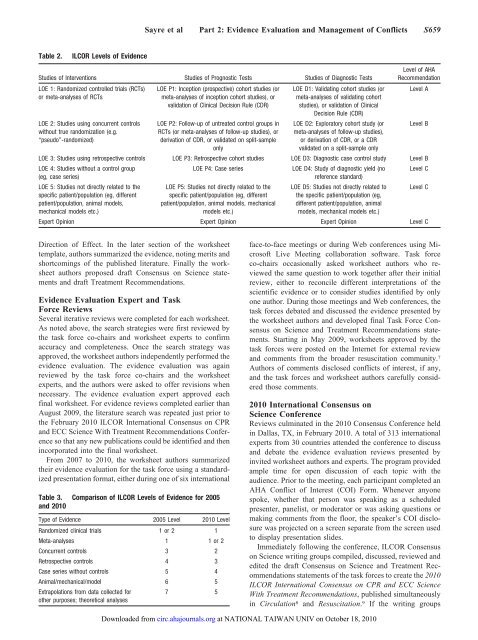2010 American Heart Association
2010 American Heart Association
2010 American Heart Association
Create successful ePaper yourself
Turn your PDF publications into a flip-book with our unique Google optimized e-Paper software.
Table 2. ILCOR Levels of Evidence<br />
Studies of Interventions Studies of Prognostic Tests Studies of Diagnostic Tests<br />
LOE 1: Randomized controlled trials (RCTs)<br />
or meta-analyses of RCTs<br />
LOE 2: Studies using concurrent controls<br />
without true randomization (e.g.<br />
“pseudo”-randomized)<br />
LOE P1: Inception (prospective) cohort studies (or<br />
meta-analyses of inception cohort studies), or<br />
validation of Clinical Decision Rule (CDR)<br />
LOE P2: Follow-up of untreated control groups in<br />
RCTs (or meta-analyses of follow-up studies), or<br />
derivation of CDR, or validated on split-sample<br />
only<br />
Direction of Effect. In the later section of the worksheet<br />
template, authors summarized the evidence, noting merits and<br />
shortcomings of the published literature. Finally the worksheet<br />
authors proposed draft Consensus on Science statements<br />
and draft Treatment Recommendations.<br />
Evidence Evaluation Expert and Task<br />
Force Reviews<br />
Several iterative reviews were completed for each worksheet.<br />
As noted above, the search strategies were first reviewed by<br />
the task force co-chairs and worksheet experts to confirm<br />
accuracy and completeness. Once the search strategy was<br />
approved, the worksheet authors independently performed the<br />
evidence evaluation. The evidence evaluation was again<br />
reviewed by the task force co-chairs and the worksheet<br />
experts, and the authors were asked to offer revisions when<br />
necessary. The evidence evaluation expert approved each<br />
final worksheet. For evidence reviews completed earlier than<br />
August 2009, the literature search was repeated just prior to<br />
the February <strong>2010</strong> ILCOR International Consensus on CPR<br />
and ECC Science With Treatment Recommendations Conference<br />
so that any new publications could be identified and then<br />
incorporated into the final worksheet.<br />
From 2007 to <strong>2010</strong>, the worksheet authors summarized<br />
their evidence evaluation for the task force using a standardized<br />
presentation format, either during one of six international<br />
LOE D1: Validating cohort studies (or<br />
meta-analyses of validating cohort<br />
studies), or validation of Clinical<br />
Decision Rule (CDR)<br />
LOE D2: Exploratory cohort study (or<br />
meta-analyses of follow-up studies),<br />
or derivation of CDR, or a CDR<br />
validated on a split-sample only<br />
Level of AHA<br />
Recommendation<br />
Level A<br />
LOE 3: Studies using retrospective controls LOE P3: Retrospective cohort studies LOE D3: Diagnostic case control study Level B<br />
LOE 4: Studies without a control group<br />
LOE P4: Case series LOE D4: Study of diagnostic yield (no Level C<br />
(eg, case series)<br />
reference standard)<br />
LOE 5: Studies not directly related to the LOE P5: Studies not directly related to the LOE D5: Studies not directly related to Level C<br />
specific patient/population (eg, different<br />
specific patient/population (eg, different the specific patient/population (eg,<br />
patient/population, animal models,<br />
patient/population, animal models, mechanical different patient/population, animal<br />
mechanical models etc.)<br />
models etc.)<br />
models, mechanical models etc.)<br />
Expert Opinion Expert Opinion Expert Opinion Level C<br />
Table 3. Comparison of ILCOR Levels of Evidence for 2005<br />
and <strong>2010</strong><br />
Type of Evidence 2005 Level <strong>2010</strong> Level<br />
Randomized clinical trials 1 or 2 1<br />
Meta-analyses 1 1 or 2<br />
Concurrent controls 3 2<br />
Retrospective controls 4 3<br />
Case series without controls 5 4<br />
Animal/mechanical/model 6 5<br />
Extrapolations from data collected for<br />
other purposes; theoretical analyses<br />
7 5<br />
Sayre et al Part 2: Evidence Evaluation and Management of Conflicts S659<br />
Level B<br />
face-to-face meetings or during Web conferences using Microsoft<br />
Live Meeting collaboration software. Task force<br />
co-chairs occasionally asked worksheet authors who reviewed<br />
the same question to work together after their initial<br />
review, either to reconcile different interpretations of the<br />
scientific evidence or to consider studies identified by only<br />
one author. During those meetings and Web conferences, the<br />
task forces debated and discussed the evidence presented by<br />
the worksheet authors and developed final Task Force Consensus<br />
on Science and Treatment Recommendations statements.<br />
Starting in May 2009, worksheets approved by the<br />
task forces were posted on the Internet for external review<br />
and comments from the broader resuscitation community. 7<br />
Authors of comments disclosed conflicts of interest, if any,<br />
and the task forces and worksheet authors carefully considered<br />
those comments.<br />
<strong>2010</strong> International Consensus on<br />
Science Conference<br />
Reviews culminated in the <strong>2010</strong> Consensus Conference held<br />
in Dallas, TX, in February <strong>2010</strong>. A total of 313 international<br />
experts from 30 countries attended the conference to discuss<br />
and debate the evidence evaluation reviews presented by<br />
invited worksheet authors and experts. The program provided<br />
ample time for open discussion of each topic with the<br />
audience. Prior to the meeting, each participant completed an<br />
AHA Conflict of Interest (COI) Form. Whenever anyone<br />
spoke, whether that person was speaking as a scheduled<br />
presenter, panelist, or moderator or was asking questions or<br />
making comments from the floor, the speaker’s COI disclosure<br />
was projected on a screen separate from the screen used<br />
to display presentation slides.<br />
Immediately following the conference, ILCOR Consensus<br />
on Science writing groups compiled, discussed, reviewed and<br />
edited the draft Consensus on Science and Treatment Recommendations<br />
statements of the task forces to create the <strong>2010</strong><br />
ILCOR International Consensus on CPR and ECC Science<br />
With Treatment Recommendations, published simultaneously<br />
in Circulation 8 and Resuscitation. 9 If the writing groups<br />
Downloaded from<br />
circ.ahajournals.org at NATIONAL TAIWAN UNIV on October 18, <strong>2010</strong>















